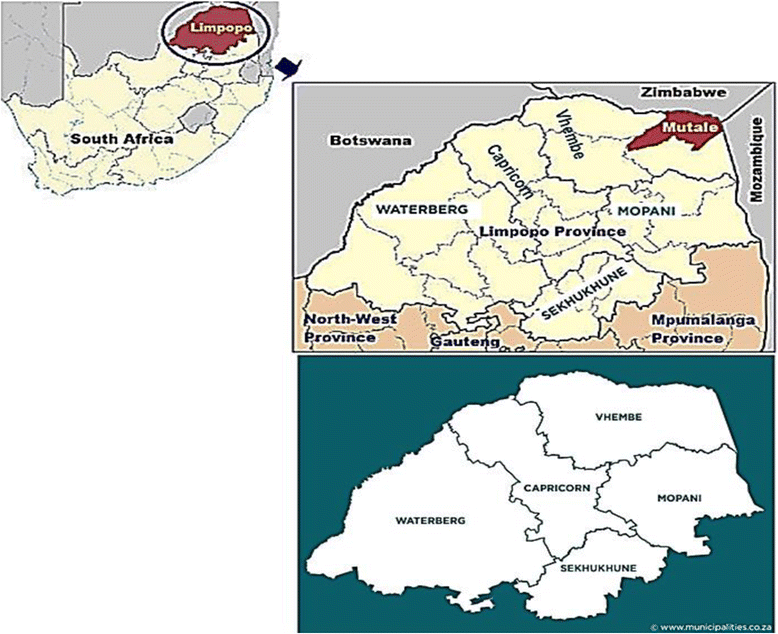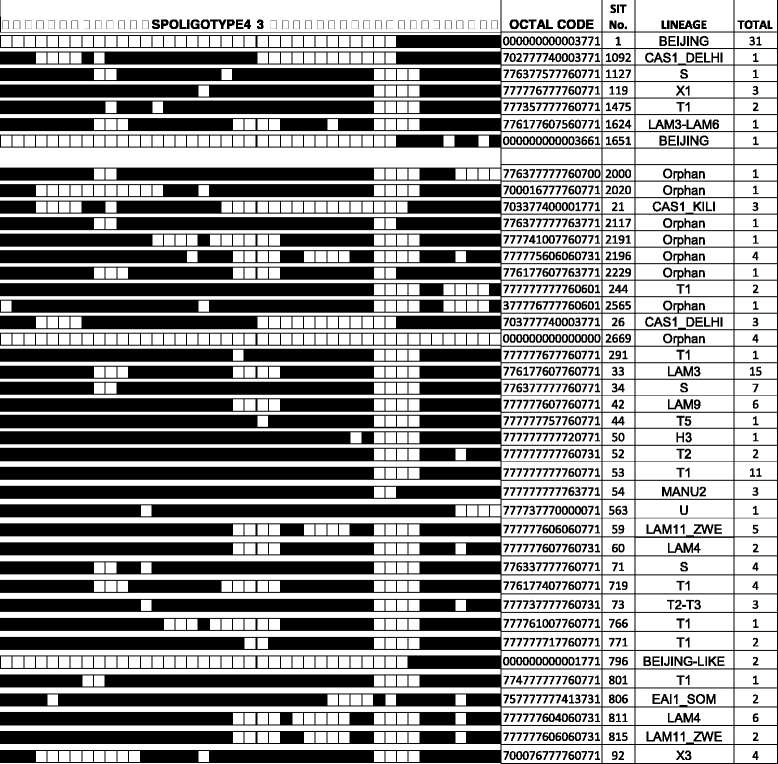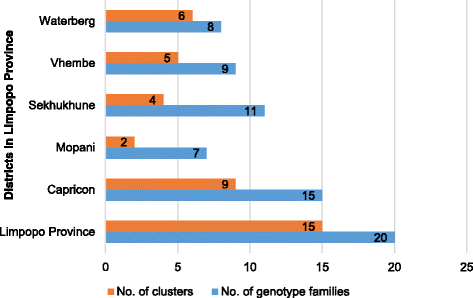Genetic diversity and distribution of Mycobacterium tuberculosis genotypes in Limpopo, South Africa
- PMID: 29233106
- PMCID: PMC5727936
- DOI: 10.1186/s12879-017-2881-z
Genetic diversity and distribution of Mycobacterium tuberculosis genotypes in Limpopo, South Africa
Abstract
Background: Tuberculosis remains a major health problem and knowledge of the diversity of Mycobacterium tuberculosis strains in specific geographical regions can contribute to the control of the disease. This study describes the genetic profile of M. tuberculosis in five districts of Limpopo Province.
Methods: A total 487 isolates were collected from the National Health Laboratory Services from all regions/districts of Limpopo Province. Only 215 isolates were confirmed to be M. tuberculosis by Bactec Mycobacterium Growth Indicator Tube 960® and Rhodamine-Auramine staining. Isolates were subcultured on Löwenstein-Jensen medium agar slants to validate purity. They were spoligotyped and data analysed using the international spoligotyping database 4 (SpolDB4).
Results: Of the 215 isolates, 134 (62.3%) were genotyped into 21 genotype families while 81 (37.7%) were orphans. The 81 orphans were further subjected to resolution employing SpolDB3/RIM. Overall, the study revealed a high diversity of strains of 32 predominantly the non-Beijing lineages: the LAM- LAM3 (9.8%), LAM9 (4.7%) and LAM11- ZWE (3.3%), the T-T1(15.0%), T2 (0.9%), T2-T3 (1.4%), the CAS-CAS1-Delhi 5 (1.9%) and CAS1-KILI (1.4%) the MANU2 (1.4%), U (0.5%), X-X1(1.4%), X3 (1.9%), S (9.8%), CAS (1.4%), LAM7(0.9%), T3(0.5%), LAM8(4.7%), T4(1.4%), X2(0.4%), AI5(1.9%), LAM1(0.5%), FAMILY33 (1.9%), EAI4(1.4%), M. microti (1.9%). The Beijing and Beijing-like families were (14.9%) and (0.9%), respectively. A total of 28(13%) clusters and 77(36%) unique cases were identified. Beijing strain (SIT 1) formed the biggest cluster constituting 14%, followed by LAM3 (SIT 33), T1 (SIT 53) and LAM4 (SIT 811) with 7%, 5.1% and 2.8%, respectively. The Beijing family was the only genotype found in all the five districts and was predominant in Mopani (18.8%), Sekhukhune (23.7%) and Vhembe (23.3%). Dominant genotypes in Capricorn and Waterberg were LAM3 (11.9%) and T1 (13.3%), respectively.
Conclusion: A wide diversity of lineages was demonstrated at district level. A high number of clusters per district provided evidence of on-going transmission in this Province.
Keywords: Genetic diversity; Mycobacterium tuberculosis; Spoligotyping.
Conflict of interest statement
Authors’ information
Optional.
Ethics approval and consent to participate
The Medunsa Research and Ethics Committee (MREC) approved this study (MREC/HS/399/2014: IR). Permission to conduct research in the Province was obtained from Department of Health and National Health Laboratory Services (NHLS), respectively after ensuring patient’s confidentiality in the research tool used.
Consent for publication
Not Applicable.
Competing interests
The authors declare that they have no competing interests.
Publisher’s Note
Springer Nature remains neutral with regard to jurisdictional claims in published maps and institutional affiliations.
Figures



Similar articles
-
Genetic Diversity of Mycobacterium tuberculosis Isolates from Assam, India: Dominance of Beijing Family and Discovery of Two New Clades Related to CAS1_Delhi and EAI Family Based on Spoligotyping and MIRU-VNTR Typing.PLoS One. 2015 Dec 23;10(12):e0145860. doi: 10.1371/journal.pone.0145860. eCollection 2015. PLoS One. 2015. PMID: 26701129 Free PMC article.
-
Genetic diversity of Mycobacterium tuberculosis in south coastal Karnataka, India, using spoligotyping.Indian J Med Res. 2018 Mar;147(3):278-286. doi: 10.4103/ijmr.IJMR_2026_16. Indian J Med Res. 2018. PMID: 29923517 Free PMC article.
-
M. tuberculosis genotypic diversity and drug susceptibility pattern in HIV-infected and non-HIV-infected patients in northern Tanzania.BMC Microbiol. 2007 May 31;7:51. doi: 10.1186/1471-2180-7-51. BMC Microbiol. 2007. PMID: 17540031 Free PMC article.
-
[A study on genotype of 271 mycobacterium tuberculosis isolates in 6 prefectures in Yunnan Province].Zhonghua Yu Fang Yi Xue Za Zhi. 2018 Jan 6;52(1):62-67. doi: 10.3760/cma.j.issn.0253-9624.2018.01.012. Zhonghua Yu Fang Yi Xue Za Zhi. 2018. PMID: 29334710 Chinese.
-
Genetic Diversity in Mycobacterium tuberculosis Clinical Isolates and Resulting Outcomes of Tuberculosis Infection and Disease.Annu Rev Genet. 2020 Nov 23;54:511-537. doi: 10.1146/annurev-genet-022820-085940. Epub 2020 Sep 14. Annu Rev Genet. 2020. PMID: 32926793 Review.
Cited by
-
Exploring the usefulness of molecular epidemiology of tuberculosis in Africa: a systematic review.Int J Mol Epidemiol Genet. 2020 Jun 15;11(1):1-15. eCollection 2020. Int J Mol Epidemiol Genet. 2020. PMID: 32714498 Free PMC article. Review.
-
Phylogenomic assessment of drug-resistant Mycobacterium tuberculosis strains from Beira, Mozambique.Tuberculosis (Edinb). 2020 Mar;121:101905. doi: 10.1016/j.tube.2020.101905. Epub 2020 Jan 29. Tuberculosis (Edinb). 2020. PMID: 32063558 Free PMC article.
-
Molecular detection of Mycobacterium tuberculosis sensu stricto in the soil of Niger.New Microbes New Infect. 2021 Sep 1;44:100939. doi: 10.1016/j.nmni.2021.100939. eCollection 2021 Nov. New Microbes New Infect. 2021. PMID: 34621525 Free PMC article.
-
The tough process of unmasking the slow-growing mycobacterium: case report of Mycobacterium microti infection.Access Microbiol. 2019 Oct 31;2(1):acmi000074. doi: 10.1099/acmi.0.000074. eCollection 2020. Access Microbiol. 2019. PMID: 33062933 Free PMC article.
-
The Detection of Mutations and Genotyping of Drug-Resistant Mycobacterium tuberculosis Strains Isolated from Patients in the Rural Eastern Cape Province.Infect Dis Rep. 2023 Jul 10;15(4):403-416. doi: 10.3390/idr15040041. Infect Dis Rep. 2023. PMID: 37489395 Free PMC article.
References
-
- World Health Organization . Global tuberculosis control: surveillance, planning, financing: the world health report 2008. Geneva: WHO; 2008.
-
- Statistics SA, 2013. From http://beta2.statssa.gov.za/publications/P03022013.pdf (Accessed 28 Jan 2016).
-
- Supply P, Allix C, Lesjean S, Cardoso-Oelemann M, Rüsch-Gerdes S, Willery E, et al. Proposal for standardization of optimized mycobacterial interspersed repetitive unit-variable-number tandem repeat typing of mycobacterium tuberculosis. J Clin Microbiol. 2006;44(22):4498–4510. doi: 10.1128/JCM.01392-06. - DOI - PMC - PubMed
MeSH terms
Substances
Grants and funding
LinkOut - more resources
Full Text Sources
Other Literature Sources
Medical

